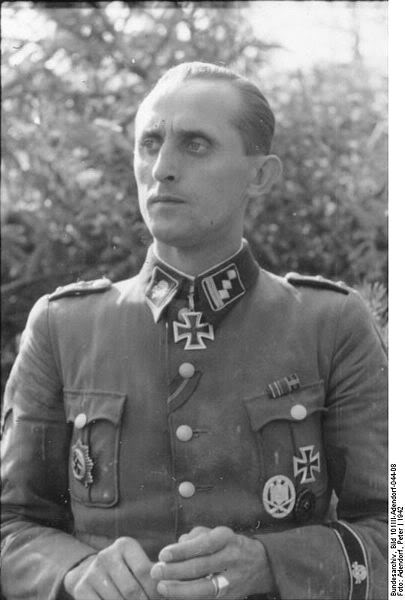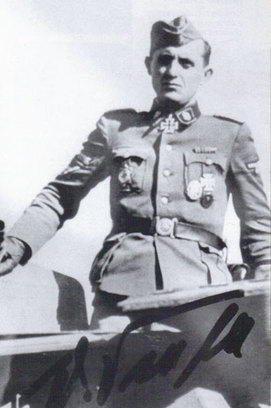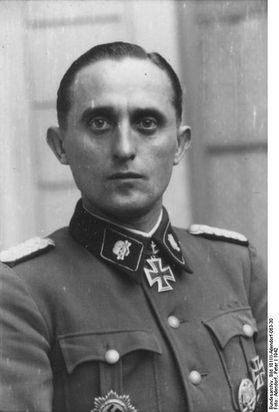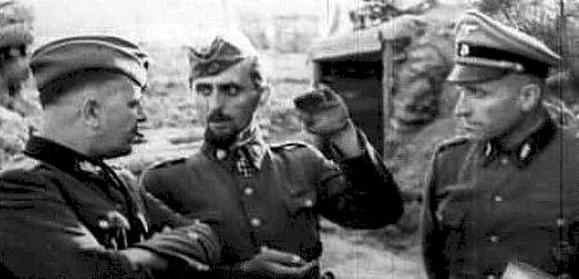awards
|
promotions
|
early life through Demjansk
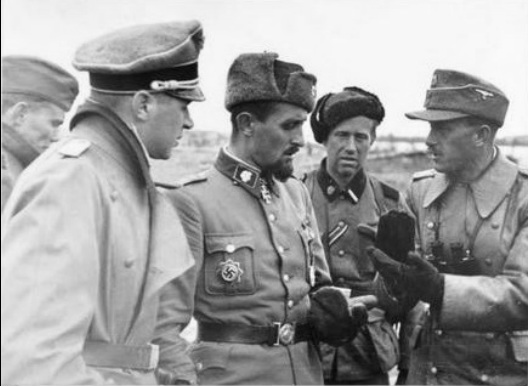
Max Seela was born on 15 July 1911 at Schöneiche near Berlin. After leaving school in 1929 he went into the Reichswehr and was then transferred into the SS-VT in 1935.
His SS service number was 257,323 and his NSDAP number was 147,126.
In September 1935 he joined the SSVT-Pioneersturmbann. He served with this unit, and participated in the occupation of Austria and the Sudetenland.
By October 1939 Seela had been transferred to the newly formed SS-Division "Totenkopf" and given command of the 3. Kompanie, SS-Pioneer-Battalion "Totenkopf".
He proved his bravery during the Invasion of France and the Low Countries. He was awarded the Iron Cross, 2nd class, in May 1940 and the Iron Cross, 1st class, in June 1940.
He took part in the invasion of the Soviet Union (Operation Barbarossa) and was awarded the German Cross in Gold in December 1941.
In September, 1941, the men of "Totenkopf" were in combat near the village of Lushno, in the Demjansk sector. On the 25th, the Soviets attacked the men of "Totenkopf" in a large offensive, in a series of attacks that lasted several days. The vulnerable junction of Lushno lay in the middle of the attack, defended by "Totenkopf" troops who refused to crack under the pressure. Weakened from three days without rations, heavy casualties, and hampered by an ammunition shortage, the men gradually gave ground around Lushno.
By evening on September 26, every officer of the 2nd Battalion, SS-Totenkopf-Infanterie-Regiment 3, including four successive battalion commanders, had been killed. The entire battalion had less than 150 survivors still in action. The division was desperate, as it's anti-tank guns were too small to destroy the Soviet tanks, but Theodor Eicke had a plan.
Eicke organized several "tank annihilation squads", which consisted of an officer, and ten men armed with satchel charges, mines, bundle grenades, and gasoline bombs. They were to attack Soviet tanks on foot, as the tanks assaulted German positions. Max Seela led one such squad, and on the 26th, his squad destroyed 7 Soviet T-34's tanks by hand, using satchel charges.
To set an example for his men and demonstrate proper finesse in hand-to-muzzle combat with armor, Seela destroyed the first tank by himself, by crawling up next to it, placing a satchel charge against the turret, and detonating the explosives with a grenade. He then personally led his men as they tackled the remaining six tanks in the same manner. After setting the tanks ablaze, Seela and his men shot down the Soviet crews as they tried to escape the blaze.
Seela is most famous for his part in the defense of the Demjansk Pocket, or perhaps for the goatee he had during that period. However, given the actions of Seela, he earned the right to have a goatee.
For over three months in the winter and spring of 1942, the men of Totenkopf were encircled by several Russian armies, numbering 10 times in size, of the men trapped in the pocket. The men made a circle around the Russian town of Demjansk, which held an airfield the Luftwaffe used to fly in supplies to the defenders. After leaving Demjansk, the SS-Totenkopfdivision would lose over 85% of it's personell, one of the most costly battles of the war. However, aside from the terrible casualties, the men of "Totenkopf" fought on, against a swarm of Soviet infantry, artillery, and armour. At this time, "Totenkopf" was still an Infanterie Division, it did not have a full compliment of tanks, like a Panzer Division, so it had to rely heavily on Anti-tank weapons.
Seela's award of the Knight's Cross was in May 1942, while Seela was a Hauptsturmführer, and in command of 3.Kp/SS-Pio.Btl. 3. "Totenkopf." Despite severe losses and meager supplies, his unit defended the Russian village of Korowitsch, east of Staraya Russa, in the Demyansk Pocket for over one month, without support.
Seela and his men prevented the village from being captured, denying the Soviet Army access to the crucial bridge over the Lowat river. Had Seela and his men given up their positions, the entire pocket would have crumbled.
When the men from SS-Totenkopf finally broke out of the encirclement at Demjansk, the first TK troops to make contact with outside German forces, were members of the 3.SS-Pioneer-Battalion, with Max Seela in command.
His SS service number was 257,323 and his NSDAP number was 147,126.
In September 1935 he joined the SSVT-Pioneersturmbann. He served with this unit, and participated in the occupation of Austria and the Sudetenland.
By October 1939 Seela had been transferred to the newly formed SS-Division "Totenkopf" and given command of the 3. Kompanie, SS-Pioneer-Battalion "Totenkopf".
He proved his bravery during the Invasion of France and the Low Countries. He was awarded the Iron Cross, 2nd class, in May 1940 and the Iron Cross, 1st class, in June 1940.
He took part in the invasion of the Soviet Union (Operation Barbarossa) and was awarded the German Cross in Gold in December 1941.
In September, 1941, the men of "Totenkopf" were in combat near the village of Lushno, in the Demjansk sector. On the 25th, the Soviets attacked the men of "Totenkopf" in a large offensive, in a series of attacks that lasted several days. The vulnerable junction of Lushno lay in the middle of the attack, defended by "Totenkopf" troops who refused to crack under the pressure. Weakened from three days without rations, heavy casualties, and hampered by an ammunition shortage, the men gradually gave ground around Lushno.
By evening on September 26, every officer of the 2nd Battalion, SS-Totenkopf-Infanterie-Regiment 3, including four successive battalion commanders, had been killed. The entire battalion had less than 150 survivors still in action. The division was desperate, as it's anti-tank guns were too small to destroy the Soviet tanks, but Theodor Eicke had a plan.
Eicke organized several "tank annihilation squads", which consisted of an officer, and ten men armed with satchel charges, mines, bundle grenades, and gasoline bombs. They were to attack Soviet tanks on foot, as the tanks assaulted German positions. Max Seela led one such squad, and on the 26th, his squad destroyed 7 Soviet T-34's tanks by hand, using satchel charges.
To set an example for his men and demonstrate proper finesse in hand-to-muzzle combat with armor, Seela destroyed the first tank by himself, by crawling up next to it, placing a satchel charge against the turret, and detonating the explosives with a grenade. He then personally led his men as they tackled the remaining six tanks in the same manner. After setting the tanks ablaze, Seela and his men shot down the Soviet crews as they tried to escape the blaze.
Seela is most famous for his part in the defense of the Demjansk Pocket, or perhaps for the goatee he had during that period. However, given the actions of Seela, he earned the right to have a goatee.
For over three months in the winter and spring of 1942, the men of Totenkopf were encircled by several Russian armies, numbering 10 times in size, of the men trapped in the pocket. The men made a circle around the Russian town of Demjansk, which held an airfield the Luftwaffe used to fly in supplies to the defenders. After leaving Demjansk, the SS-Totenkopfdivision would lose over 85% of it's personell, one of the most costly battles of the war. However, aside from the terrible casualties, the men of "Totenkopf" fought on, against a swarm of Soviet infantry, artillery, and armour. At this time, "Totenkopf" was still an Infanterie Division, it did not have a full compliment of tanks, like a Panzer Division, so it had to rely heavily on Anti-tank weapons.
Seela's award of the Knight's Cross was in May 1942, while Seela was a Hauptsturmführer, and in command of 3.Kp/SS-Pio.Btl. 3. "Totenkopf." Despite severe losses and meager supplies, his unit defended the Russian village of Korowitsch, east of Staraya Russa, in the Demyansk Pocket for over one month, without support.
Seela and his men prevented the village from being captured, denying the Soviet Army access to the crucial bridge over the Lowat river. Had Seela and his men given up their positions, the entire pocket would have crumbled.
When the men from SS-Totenkopf finally broke out of the encirclement at Demjansk, the first TK troops to make contact with outside German forces, were members of the 3.SS-Pioneer-Battalion, with Max Seela in command.
In July 1942 Seela was given command of the 3.SS-Pioneer-Battalion "Totenkopf" until April 1944 when he was appointed commander of the II. SS Panzer Corps Pioneers.
He was then given command of the 19.SS-Panzer-Grenadier-Regiment, 9.SS-Panzer-Division "Hohenstaufen".
On 8 May 1945, Seela was captured by American forces and became a prisoner of war.
Max Seela died in Ratingen, at the age of 88 on 31 July 1999.
He was then given command of the 19.SS-Panzer-Grenadier-Regiment, 9.SS-Panzer-Division "Hohenstaufen".
On 8 May 1945, Seela was captured by American forces and became a prisoner of war.
Max Seela died in Ratingen, at the age of 88 on 31 July 1999.
DISCLAIMER: 2. Kompanie is a non-political organization We do not support naziism, or fascism. We are not associated with nor do we condone the actions of the Third Reich or the actual 3.SS Division.
